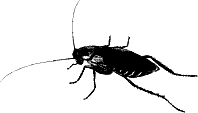 | Wasps Use a "Brainy" Attack to Gather Prey |
 | Wasps Use a "Brainy" Attack to Gather Prey |
|
August 22, 2003
If you are frightened easily, stop reading this article immediately. But if you want to learn about the fascinating way that wasps hunt cockroaches, then this story is for you.  Many animals use toxins that target their prey's nervous system. These neurotoxins usually work to paralyze the prey. Researchers have found one animal, the predatory wasp, that uses its venom not to paralyze, but to change the behavior of its victim.
Scientists have known that predatory wasps sting cockroaches twice: the
first sting targets the thorax of the cockroach, the second sting targets
the head. The venom injected by the stings does not paralyze the
cockroach. Rather, after being stung, the cockroach cleans itself, then
slows down. The wasp then grabs an antennae of the cockroach and leads it
to a place where it can deposit its eggs. A few days later, the wasp's
offspring hatch and dine on the cockroach. Researchers have discovered
that the brain of the cockroach takes a direct hit by the second wasp
sting. To identify the exact location of wasp stings, scientists at Ben-Gurion University (Beer-Sheva, Israel) marked wasps by injecting them with radioactive material. This injection labeled the wasp venom with radioactivity. The wasps were then allowed to sting cockroaches. Radioactivity was injected each time a wasp stung a cockroach. When tissues of stung cockroaches were examined, the researchers found that the brain of the cockroach had a higher level of radioactivity than other parts of the body, including non-neural tissue in the head. To make sure that the radioactive label did not spread from non-neural tissue to the brain, the researchers in a separate experiment injected radioactive material into areas around the brain. When these tissues were examined, most of the radioactivity was located in non-neural tissue, not the brain. From these data, the scientists concluded that the second wasp sting targets the cockroach brain directly. The researchers also measured the length of a wasp stinger. They found that the stinger had a length of 2.5 mm. This is long enough to reach the cockroach brain, which is located 1 to 2 mm deep in the head. According to the scientists, this wasp-to-cockroach sting is the only known example where a predator injects its venom directly into the central nervous system of its prey. They speculate that the first sting into the thorax of the cockroach helps the wasp target the brain more precisely. |
Reference and further information:
|
| GO TO: | Neuroscience In The News | Explore the Nervous System | Table of Contents |
![[email]](./gif/menue.gif) Send E-mail |
 Fill out survey |
 Get Newsletter |
 Search Pages |
 Take Notes |